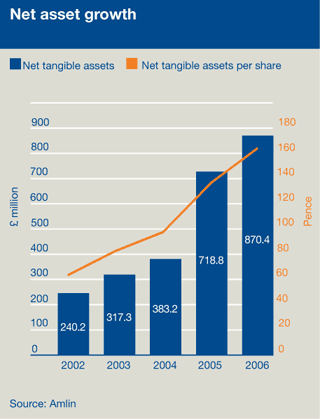Operating & Financial Review
Balance sheet management – enhancing returns
|
|
The following chart illustrates the growth in net tangible assets and net tangible assets per share since 2002.
Understanding the level of capital
 In order to understand the level of capital
required to run the business, Amlin has in recent
years invested considerable resources into
developing its dynamic financial analysis (DFA)
model. The DFA model predicts a range of
possible financial outcomes for each area of
our business, incorporating underwriting and
investments, and for the business as a whole
by running thousands of simulations through
a stochastic model which is derived from
historic and expected variability in claims.
In order to understand the level of capital
required to run the business, Amlin has in recent
years invested considerable resources into
developing its dynamic financial analysis (DFA)
model. The DFA model predicts a range of
possible financial outcomes for each area of
our business, incorporating underwriting and
investments, and for the business as a whole
by running thousands of simulations through
a stochastic model which is derived from
historic and expected variability in claims.
Developing this modelling for the medium term is important from a Group perspective because it provides a dynamic picture of how capital requirements may develop. However, with Amlin Bermuda in its early period of operation it is clear that, for Bermuda, we are carrying capital above the level required for the current underwriting and investment risk. The actual level of capital, as we explained last year, was driven by commercial reasons – that is US$1 billion of capital was the minimum level which would be required to trade with our desired client base.
Therefore the focus of modelling has been for the London operations where it supports our regulatory capital assessment. The Group is required to submit an annual Individual Capital Assessment (ICA) to Lloyd’s, which sets out the level of capital that is required to contain the risk of insolvency in any year to no greater than a probability of 0.5%. This is equivalent to a BBB insurance financial strength rating level. Lloyd’s reviews the submissions for all syndicates in the market with the intent of bringing all ICAs to an equivalent level. At that point the ICA figure is uplifted by 35% to bring the capital to a level to support a higher financial strength rating.
For Syndicate 2001, our uplifted ICA remains below the minimum ratio of 40% that Lloyd’s continues to require and so our capital ratio defaults to that minimum.
Adjusting the level of equity and debt capital deployed
Once the level of capital required is determined the next critical decision is what mix of debt and equity is deployed to meet medium and long term capital needs. Our underlying approach remains unchanged – debt capital should form an important element of the capital employed by the Group when underwriting margins are strong. When underwriting margins weaken the proportionate level of debt deployed to meet our capital requirement should fall.
This approach is driven by the scale and type of underwriting risk that the businessis exposed to over a given period of time. Typically we will grow when underwriting margins increaseand, due to the diversity of the business, the abilityof the income statement to absorb volatility from catastrophic events is greater. Therefore, we would typically utilise debt to grow.
Finally, in order to enhance our return on equity, as actual capital levels in the business exceed our capital requirements, we would expect to return capital to shareholders. The level of capital return will depend upon maintaining levels of capital that we believe are commensurate with our medium term growth ambitions, that is supportive of our financial strength rating assigned by rating agencies and which provides clients with the necessary assurance over our ongoing financial strength.
Our commitment to return of capital is illustrated by the special dividend payments that we have announced with the 2006 results.
The enhancement of return on equity through active capital management in recent years is illustrated below:
ROE and ROC adjusted gearing after excluding bridge finance
Type of debt employed
We explained in last year’s annual report that we had begun to focus more of our attention on the type of debt instrument that we were using in our capital structure. Historically, we had relied upon short term commercial bank debt in the form of letters of credit (LOCs) for solvency capital purposes.
This form of debt had been flexible and relatively inexpensive compared to prospective earnings. However, the FSA have moved to a stricter regime for defining what is acceptable solvency capital for insurance operations in the UK. LOCs are still acceptable under this regime for a pure Lloyd’s operation but there is a risk that as a new solvency regime is rolled out across the wider European Community, the use of such instruments may become more restricted.
Therefore in 2004 and 2005 Amlin issued long term subordinated debt which fitted the new definition of acceptable solvency capital. This debt provides the Group with better quality debt capital. It is longer term, unsecured and contains no financial covenants which could lead to early forced repayment. Also, importantly, if structured correctly this form of debt is recognised as capital by a number of the rating agencies.
With this in mind, Amlin raised a further £230 million of subordinated debt in the UK market in April 2006. This refinanced the short term debt Investment management that was used to finance Amlin Bermuda and removed all reliance on LOCs.
Following the completion of this transaction, the capital position of the Group was more robust. At that point we were in a position to renegotiate our banking facilities in order to add to the financial strength of the Group and to provide greater future flexibility. The new facility, which was completed in November 2006, is an unsecured £200 million three year revolving credit facility. Amlin Bermuda has also negotiated an unsecured US$100 million facility.
These changes provide the Group with greater ability to manage its equity and debt mix in the future without undermining the ability of the business to grow in the event of sudden changes to market conditions.
Insurance leverage and liquidity
The Group’s cash and investments have continued to grow. This is illustrated below.
The growth in 2006 reflects further profitable trading within the syndicate and now through Amlin Bermuda. Cash and investments represent a multiple of 2.5 times (2005: 2.7 times) shareholders’ equity.
This is also an important client proposition as our ability to respond to claims quickly in the event of large catastrophic losses is core to our proposition as an insurer of choice. The funds of the business can readily absorb the modelled losses from our realistic disaster scenarios.
In addition, in order to aid working capital management a new US$200 million secured LOC facility for syndicate regulatory funding purposes was put in place in November 2006 and Amlin Bermuda negotiated a US$200 million LOC facility to provide collateral to clients when required. These funding facilities add to the working capital strength of the Group for funding future catastrophe losses.
Efficient cash management of an insurer is a source of value. On average we retain premiums for around three years before claims are settled. On large claims where reinsurance collections are due, we have to pay out the claim in advance of the collection from reinsurers and rapid reinsurance response is important.
Therefore effective credit management of premiums and reinsurance collectibles improves our performance and we have concentrated efforts in this area.
As we noted last year, the rapid collection of the 2005 hurricane claims would be a priority for 2006. We have performed well, with US$398 million of reinsurance collections made by 31 December 2006 against payments of US$425 million.
The credit quality of reinsurance debt remains good as illustrated below.

